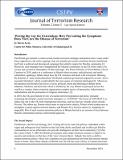Files in this item
Paving the way for extremism: how preventing the symptoms does not cure the disease of terrorism
Item metadata
| dc.contributor.author | Awan, Imran | |
| dc.date.accessioned | 2013-08-28T15:41:11Z | |
| dc.date.available | 2013-08-28T15:41:11Z | |
| dc.date.issued | 2011-11-11 | |
| dc.identifier.citation | Awan, I. (2011). Paving the way for extremism: how preventing the symptoms does not cure the disease of terrorism. Journal of Terrorism Research, 2(3), pp. 4-8. | en_US |
| dc.identifier.issn | 2049-7040 | en_US |
| dc.identifier.uri | http://ojs.st-andrews.ac.uk/index.php/jtr/article/view/224 | en_US |
| dc.identifier.uri | https://hdl.handle.net/10023/4010 | |
| dc.description.abstract | The British government’s controversial counter-terrorism strategies and policies have come under fierce opposition with critics arguing it has not actually prevented extremism but has manifested itself into a political and ideological campaign that unfairly targets the Muslim community. Moreover, such strategies have marginalised the Muslim community in the UK from wider civic society and created an atmosphere of hate and anger. The Prime Minister of Great Britain, David Cameron in 2010, spoke at a conference in Munich about security, radicalisation, and multi-culturalism, sparking a debate about how the UK monitors and deals with extremism. Blaming the doctrine of ‘state-multiculturalism’ the British coalition government argued for a more ‘active muscular liberalism’ which would identify the root causes of extremist ideologies. Moreover, this paranoia and hysteria has led to a social, political, moral and theological debate about Islamism, Muslims, and terrorism which is fuelled by the way Britain is portrayed across the world as a country where extremist organisations employ tactics of persuasion, indoctrination, radicalisation and the promotion of religious intolerance. | en_US |
| dc.language.iso | en | en_US |
| dc.publisher | Centre for the Study of Terrorism and Political Violence, University of St Andrews | en_US |
| dc.relation.ispartof | Journal of Terrorism Research | en_US |
| dc.rights | This is an open access article published in Journal of Terrorism Research. This work is licensed under a Creative Commons Attribution 3.0 License (http://creativecommons.org/licenses/by/3.0/) | en_US |
| dc.rights.uri | http://creativecommons.org/licenses/by/3.0/ | |
| dc.subject | Law | en_US |
| dc.subject.lcc | HV6431 | en_US |
| dc.subject.lcsh | Terrorism | en_US |
| dc.title | Paving the way for extremism: how preventing the symptoms does not cure the disease of terrorism | en_US |
| dc.type | Journal article | en_US |
| dc.description.version | https://doi.org/Publisher PDF | en_US |
| dc.publicationstatus | Published | en_US |
| dc.status | Peer reviewed | en_US |
| dc.identifier.doi | https://doi.org/http://doi.org/10.15664/jtr.224 | en |
This item appears in the following Collection(s)
Except where otherwise noted within the work, this item's licence for re-use is described as This is an open access article published in Journal of Terrorism Research. This work is licensed under a Creative Commons Attribution 3.0 License (http://creativecommons.org/licenses/by/3.0/)
Items in the St Andrews Research Repository are protected by copyright, with all rights reserved, unless otherwise indicated.


